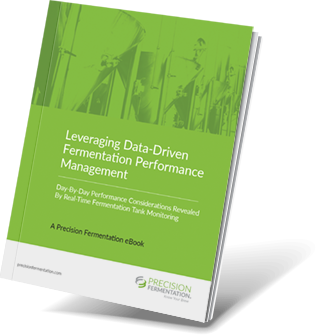Yeast Harvesting: Best (& Worst) Practices and How to Know When It’s Time to Pitch Fresh Yeast

Brewers commonly repitch yeast to ferment batch after batch to save money and coax out the complex flavors and higher flocculation rates that Saccharomyces yeast can develop over multiple generations, particularly from the second to the third.
But in order to maximize yeast function and longevity, it’s important to be strategic and maintain consistency when you harvest (AKA “crop”) the yeast and which parts to take, along with how long you store your slurry and under what conditions.
These best practices for yeast harvesting can generate seven to 10 generations from one initial purchase.
7 Yeast Management Best Practices – Tips, Tricks, and Traps |
1. Can You Store Your Yeast in the Fermenter?
Not recommended. Because yeast acts as an insulator, the middle layer of the yeast cake that forms at the bottom of a cylindroconical fermenter (CCV) can heat up. When yeast temperature rises, life expectancy falls.
2. When to Begin Yeast Harvesting?
In a cylindroconical tank it’s wise to remove yeast slurry shortly after fermentation finishes and beer has chilled to below 40 degrees, typically within 48 hours. In an open vessel, cropping should happen once gravity has fallen at least 50%.
Note: Don’t harvest from problematic fermentations. You want your slurry to look creamy with no trub, off-flavors or aromas.
3. Which Yeast Harvesting Method is Best?
While skimming off the top of an open vessel results in cleaner, more predictable and more viable yeast for repitching, modern brewers tend to employ conical tanks more often. With their cone-shaped bottoms, CCFs allow brewers to easily discharge trub and collect flocculated yeast.
Matthew Farber, director of the Brewing Science Certificate Program at Philadelphia’s University of the Sciences, says, “To the port a brewer should clamp a sight glass followed by a t-pipe fitting with valves on each side. Attached to hoses, the two t-pipe ports can be directed to waste, yeast brink, or bright tank.”
Watch for the dark trub to clear then switch the valve to direct the healthy yeast into the collection vessel.
4. Which Part of the Yeast to Extract?
Regardless of which type of vessel you use, you want to crop from the middle.
In a conical tank, the best yeast cells to harvest settle into a middle layer at the bottom between the first layer, consisting of trub and cells that flocculate early, and the top layer,
In an open vessel, discard the first, “dirt,” skim, harvest the second skim that rises and toss any subsequent ones.
Best practices:
- Dial in 1-4 PSI of CO2 head pressure in the tank to prevent oxidation or a vacuum when harvesting.
- Because slurry contains CO2 that makes yeast expand and turn to foam, leave 1/4 to 1/3 of the brink’s volume empty.
- Don’t let the trub and yeast pour through the port too fast or you’ll end up with tunneling.
Farber explains tunneling this way: “If, during transfer, a valve is opened too far, the yeast slurry flows too quickly, pulling yeast from the center of the cone. With rapid transfer, the yeast ‘stick’ to the walls and cannot settle fast enough to be collected through the bottom port.”
This residual yeast ends up sitting on the beer too long, killing off its cells and forming off-flavors like acetaldehyde and astringent bitterness.
5. What Vessels Can I Use to Store the Yeast Between Batches?
Before putting a yeast storage vessel into action, disassemble and soak the fittings to wipe out any bacteria, and purge the vessel with CO₂ to minimize the slurry’s contact with oxygen.
Cornelius kegs, soda kegs and covered food-grade plastic buckets make for simple and inexpensive storage containers. However, because they don’t vent pressure, shake and vent the kegs once a day or more and vent the buckets periodically.
6. How Do I Keep My Yeast Viable?
As with anything, proper yeast management is key. Ideally you should use it within 1-3 days.
“If less than two weeks, brewers will usually have no problem reusing yeast. After four weeks, the viability of yeast slurry is usually 50% or lower,” writes White Labs President Chris White on his blog.
To prolong life within this time span, keep the yeast at 34-36 degrees in a dark space free of oxygen. Oxygen and warm temperatures reduce lifespan and cause bacteria to form more quickly.
7. How Do I Know if My Yeast is Healthy Enough to Reuse?
Before storing and again before re-pitching, brewers should test their yeast for viability and contamination. Ideally, you’ll use yeast that is more than 95% and no less than 70% viable.
If a beer is contaminated, the culture will also be contaminated. Check the slurry for aerobic and bacteria, and wild yeast. Don’t use the slurry if bacteria counts are over 1 per ml, and wild yeast is over 1 per 0.1ml.
One Final Note
Always harvest from a low-gravity and low-hop beer. High gravity and/or highly hopped beers can stress the yeast and result in poor later fermentations. Don’t harvest yeast from beers with higher than 6.5% ABV.
The BrewMonitor System enables craft brewers to live-stream DO, pH, gravity, pressure, internal/external temperature and conductivity data to any smart phone, tablet or PC. It also sends instant alerts if a fermentation’s metrics go out of range. It helps increase efficiency, save money, and improve batch-to-batch consistency.
Free eBook: Leveraging Data-Driven Fermentation Performance Management
Can fermentation management be improved, as a process? This eBook explores, in detail, how fermentation performance data analysis helps elevate product and business outcomes in a modern brewery, whether brewpub, microbrewery or regional craft brewer.
You will learn:
- Day-by-day performance considerations – learned through the extensive examination of real-time fermentation tank data.
- Key recommendations from the Precision Fermentation science team at each major step of fermentation – “Day zero” (i.e. before you pitch your yeast), the first 24 hours, and day two through the end of fermentation.
- Best practices – Activity to watch out for, broken down by each key measurement – Dissolved oxygen, gravity, pH, pressure, internal/external temperature, and conductivity.
- Key findings that can help you solve problems and improve your results.
About the Author
Tara Nurin is the beer and spirits contributor to Forbes, the drinks columnist for New Jersey Monthly, a co-host of the weekly What’s on Tap TV show, and a writer for publications like Food & Wine and Wine Enthusiast. The certified beer judge teaches a for-credit university beer class and leads beer seminars for institutions like the Smithsonian. The former broadcast news reporter has won two first place awards from the North American Guild of Beer Writers, founded NJ’s original beer education group for women and volunteers as the archivist for the Pink Boots Society for women in the beer industry. She’s currently writing a book about the history of women in beer for publication in spring 2021.



Yeast can be repitched anywhere from 7 to 50 times. see:
Speers, R.A., Rogers, P. and Smith B. 2003. Non-linear modeling of brewing fermentations. J. Inst. Brew.109:229-235
Speers, R.A. and Stokes, S. 2009. Effects of vessel geometry, fermenting volume and yeast repitching on fermenting beer. J. Inst. Brew. 115:148-150.
Josey, M., Bryce, J. and Speers, R.A. 2016. Relationships between the speed of fermentation and levels of flavour compounds post-fermentation. Young Scientists Symposium Chico, CA. https://youngscientistssymposium.org/YSS2016/ pdf/Josey.pdf.
Bühligen F, Lindner P, Fetzer I, Stahl F, Scheper T, Harms H, Müller S. 2014. Analysis of aging in lager brewing yeast during serial repitching. J. Biotechnol. 187:60-70.
In a recent paper we note a number studies of industrial data from Australian, Austrian, Canadian lagers and Scottish ales have shown that the crop number (i.e., the number of repitches of yeast) have little or no effect on fermentation rate. The number of rep itches needs to statistically examined in each process.